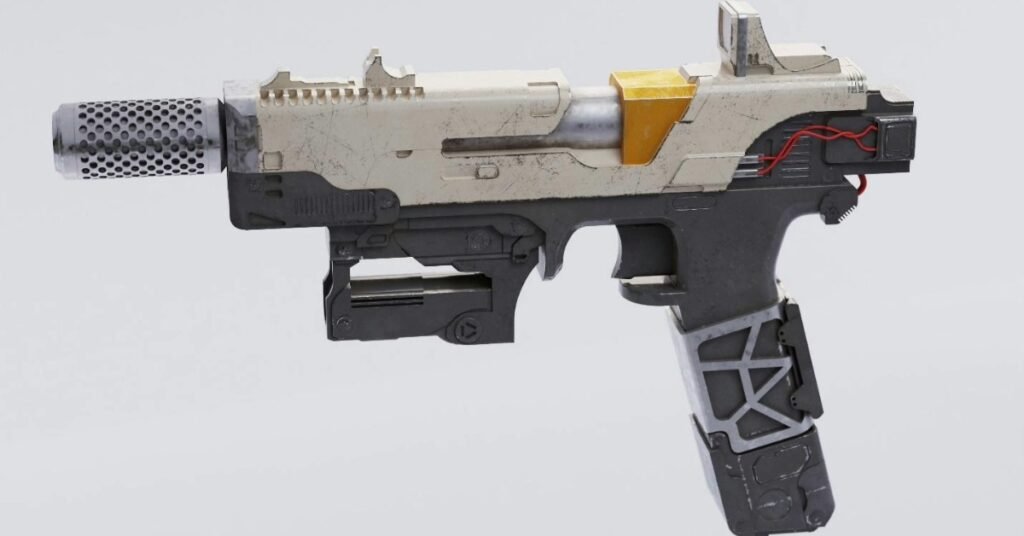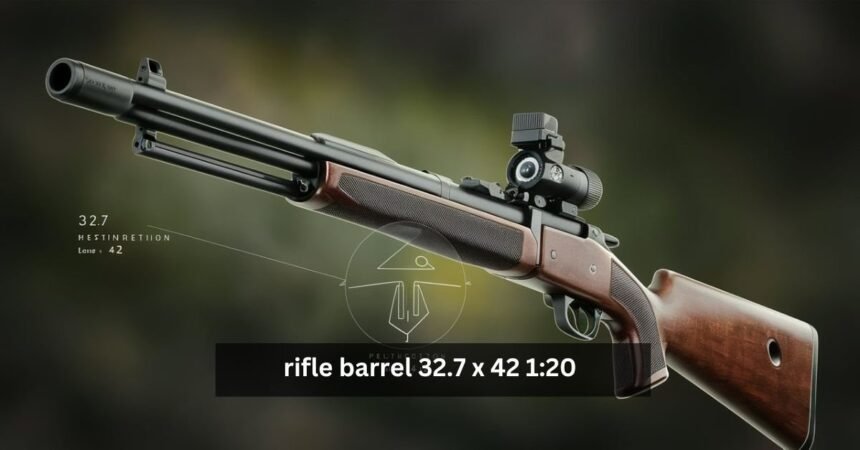Introduction to Rifle Barrel 32.7 x 42 1:20
When it comes to precision shooting, the right equipment can make all the difference. Enter the rifle barrel 32.7 x 42 1:20—a specific choice that combines unique dimensions and twist rates for optimal performance. Whether you’re a seasoned marksman or just stepping into the world of firearms, understanding this barrel type is essential for enhancing your shooting skills.
Imagine hitting your target with unmatched accuracy while enjoying every moment spent at the range or in the field. The right knowledge about this particular rifle barrel can elevate not just your game but also your confidence as a shooter. Let’s dive deeper into what makes the rifle barrel 32.7 x 42 1:20 so intriguing and how you can master its potential for an exceptional shooting experience!
Understanding the Basics of Barrel Twist Rates
Barrel twist rates play a crucial role in how well a bullet stabilizes during flight. Simply put, the twist rate refers to the distance it takes for the rifling inside the barrel to make one complete turn. For example, a 1:20 twist means that for every 20 inches of barrel length, there is one full rotation of rifling.
This measurement significantly affects accuracy and stability. A faster twist rate—like 1:10—works better with heavier bullets by providing more spin. Conversely, slower twists are suited for lighter projectiles.
Understanding your specific needs guides you in choosing the right rates for your rifle barrel 32.7 x 42 1:20 setup. Experimenting with different combinations helps shooters find their sweet spot in performance and precision on target.
Choosing the Right Barrel for Your Needs

Choosing the right barrel for your rifle is crucial to achieving optimal performance. Consider the purpose of your firearm first. Are you hunting, target shooting, or competing? Each application demands different characteristics from a barrel.
Next, pay attention to caliber compatibility. The 32.7 x 42 specification needs to match with the ammunition you plan on using for best results. A wrong fit can hinder accuracy and efficiency.
Twist rate also plays a significant role in overall performance. The 1:20 twist in this barrel size provides stability for various bullet weights but may not suit every type of projectile.
Think about material and finish options that align with your environment and handling preferences. Stainless steel offers corrosion resistance while carbon steel might provide better rigidity at lighter weight. Your choice here will affect durability as well as ease of maintenance over time.
Proper Maintenance and Care for Your Rifle Barrel
Maintaining your rifle barrel is essential for ensuring long-lasting performance. Regular cleaning is crucial to remove residue and prevent corrosion. Use a quality bore cleaner and a proper cleaning rod to avoid damaging the rifling.
Inspect your barrel periodically for any signs of wear or damage. Look out for pitting, rust, or scratches that could affect accuracy. If you notice anything unusual, consider consulting a professional gunsmith.
Lubrication also plays a vital role in maintenance. A light application of oil can help protect against moisture and dirt buildup. Avoid over-lubricating; it can attract debris instead of repelling it.
Store your rifle properly when not in use. Keep it in a climate-controlled environment to minimize temperature fluctuations that could lead to rust formation.
Handling with care during shooting sessions will also extend the lifespan of your barrel significantly, keeping it free from unnecessary stress or impact damage.
Tips for Improving Accuracy with Barrel 32.7 x 42 1:20
To improve accuracy with your rifle barrel 32.7 x 42 1:20, mastering your shooting stance is essential. A stable position allows for better control and reduces movement while aiming.
Focus on breathing techniques as well. Inhale deeply and exhale slowly before taking the shot. This will help calm your nerves, making you less likely to flinch.
Experimenting with different ammunition types can also yield surprising results. Some rounds may perform significantly better than others in terms of precision.
Don’t underestimate the importance of a quality trigger pull either. A smooth, consistent trigger action minimizes disturbance when firing.
Regularly clean your barrel and inspect it for wear or damage too. A well-maintained barrel enhances performance and consistency over time.
Practice regularly at varying distances to build confidence and skill with this specific setup. Each session strengthens muscle memory and sharpens focus under pressure.
Recommended Ammo Types and Loads for Optimal Performance
When selecting ammo for your rifle barrel 32.7 x 42 1:20, it’s crucial to consider the type and load that best suits your shooting needs.
For target shooting, high-quality full metal jacket (FMJ) rounds are often recommended. They provide consistent performance at various distances without excessive wear on the barrel.
If you’re hunting or looking for personal defense options, soft point (SP) or hollow point (HP) bullets can offer greater expansion upon impact. These types ensure effective terminal ballistics while maintaining accuracy.
Another factor is grain weight. Typically, lighter bullets (around 150-170 grains) work well with this caliber, but experimenting with heavier loads might yield better results depending on specific conditions and requirements.
Always test different brands and bullet designs to find what functions best in your setup. Each rifle may respond uniquely to varying ammunition types and loads based on its characteristics.
Advanced Techniques for Mastering Rifle barrel 32.7 x 42 1:20
Exploring advanced techniques for the rifle barrel 32.7 x 42 1:20 can elevate your shooting game significantly.
Consider experimenting with handloading ammunition. Tailoring loads to match your specific barrel twist rate enhances performance and accuracy. A custom load helps you achieve the ideal balance between speed and stability.
Another technique involves adjusting your shooting stance and grip. Subtle changes in body positioning can lead to more consistent shot placement. Focus on creating a stable platform that minimizes movement during recoil.
Don’t overlook the importance of analyzing environmental factors, such as wind direction and humidity levels. Understanding how these elements affect bullet trajectory allows for better adjustments before taking a shot.
Practice dynamic shooting drills that mimic real-life scenarios. This not only builds muscle memory but also improves reaction times under pressure, making you a more versatile shooter with the rifle barrel 32.7 x 42 1:20.
FAQs About Rifle Barrels and Their Performance
When it comes to rifle barrels, especially the 32.7 x 42 1:20 variant, it’s normal to have questions about their performance and specifications. Here are some common inquiries that can help clarify any uncertainties you may have.
What does the designation “32.7 x 42” signify?
The numbers indicate the caliber diameter (32.7mm) and barrel length (42 inches). This combination is designed for specific uses in shooting sports or hunting.
Why is barrel twist rate important?
The twist rate affects how effectively a bullet stabilizes in flight. A 1:20 twist means one full rotation of the bullet occurs every twenty inches of travel down the barrel, ideal for certain projectile weights.
How do I know what ammo works best with my rifle barrel?
Consult your manufacturer’s guidelines or try different types of ammunition during practice sessions to find optimal performance based on accuracy and grouping.
Can I use hand-loaded ammunition with a 32.7 x 42 rifle barrel?
Yes, as long as they meet safety standards and specifications suitable for this type of barrel, hand loads can often enhance your shooting experience.
What maintenance practices should I adopt regularly?
Regular cleaning after each outing helps maintain performance integrity while periodic inspections will ensure there are no obstructions or wear affecting accuracy.
Are there upgrades available for enhancing my rifle’s capabilities?
Upgrades such as precision optics, enhanced triggers, or specialized stocks can complement your existing setup without needing to change your entire firearm system.
Understanding these aspects not only enhances your proficiency but also ensures that you get the most from your rifle barrel’s design and capabilities. Whatever questions arise about maintaining or optimizing performance with a .32-7×4-2 inch at a one-in-twenty twist ratio will undoubtedly lead you toward mastering this unique component of shooting equipment.
